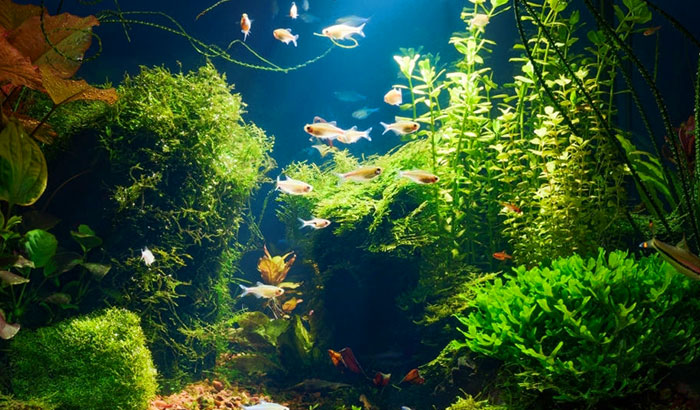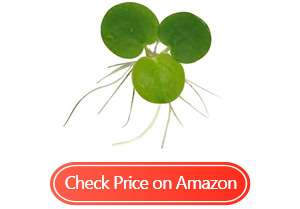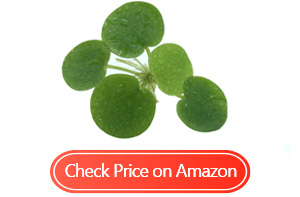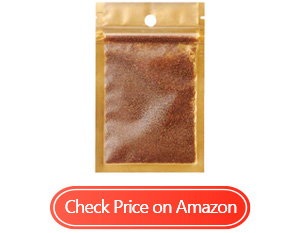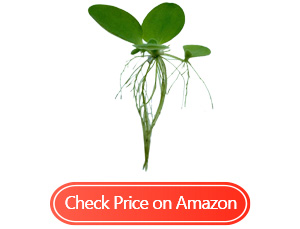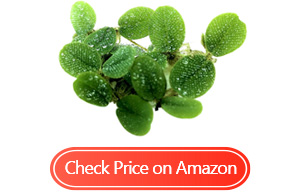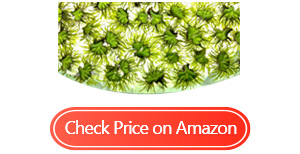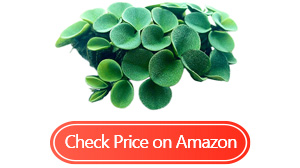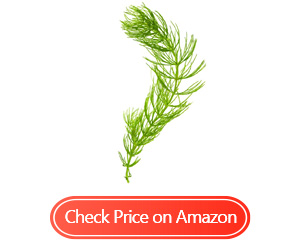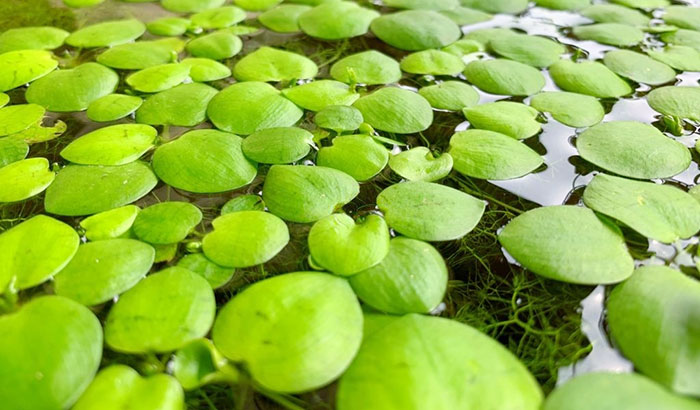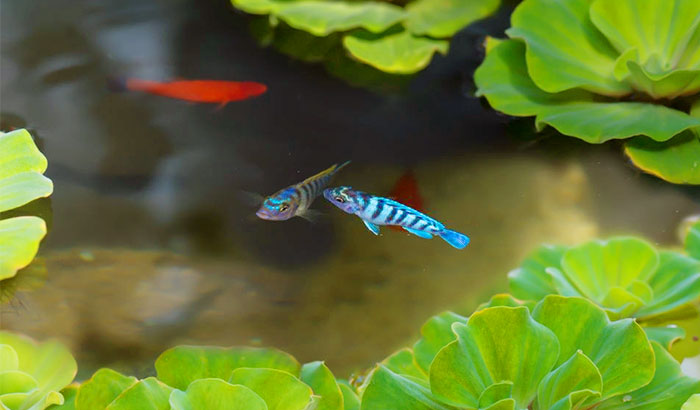Do you want to up your aquarium game? Then you can start by removing all those tacky plastic plants and replacing them with real aquatic ones. Having real plants in your aquarium is more beneficial as such can give your fish a natural environment to live in.
Moreover, the best aquarium plants for nitrates can help by promoting a natural nitrogen cycle in the tank. It means that the plants will be dealing with the nitrates and ammonia that come from fish waste, resulting in less fouling and fewer water changes.
For you to get suitable aquarium plants to reduce nitrates for your fish tank, consider the tips and suggestions indicated in this article. Let’s start with product reviews first.
Contents
Best Aquarium Plants to Reduce Nitrates Reviews
1. Aqua L’amour Amazon Frogbit
One thing that impressed me about these plants is that they are already matured and established upon ordering. Each plant will have at least 2 leaves each. Meanwhile, their roots are around a foot in length. Although it is best to acclimate them, it is unnecessary to do any acclimation in a separate bucket. You can just throw them into your tank.
Another great thing about this plant is that it thrives without having to add extra nutrients to the water. This plant can survive in any aquarium setting. The only things they need are the nitrates that come from fish waste as nourishment. This means you do not have to add stress to your fish by adding nutrients into the water.
Unlike some aquatic plants, the Amazon Frogbits do not need CO2 constantly pumped into the water. It is one less tank accessory that you will need to get. Of course, these plants will appreciate the supplemental CO2, but they can do without it and still be fine.
Moreover, the plants that are the best nitrate remover for freshwater also do not need any fancy full-spectrum, high-wattage grow lights. Just your regular LED lamp will supply enough light for them to thrive. If the location of the aquarium gets several hours of natural indirect light, that would be enough to keep these plants happy.
The only problem with them is that they are somewhat sensitive to fluctuating temperatures. If these plants need to be shipped far, exposing them to the fluctuating ambient temperatures too much, they might arrive damaged, or worse DOA. Damaged plants upon arrival may be difficult to nurse back to health.
- Each plant is mature with 2-3 leaves each
- Does not need additional nutrients in the water
- No need for CO2
- Can thrive with just an LED grow light
- Spreads fast
- Delicate against temperature changes
If you are a beginner at taking care of aquatic plants, then these plants are ideal for you. They do not need any additional care aside from what you are already doing for your tank.
2. Aquarigram Leaf Amazon Frogbit
One thing I liked about this supplier of aquatic plants is that each order contains a lot of Frogbits recognized as among the best pond plants to reduce nitrates. You will be getting around ten or so plants with 2-3 leaves each. In a couple of weeks, these plants will cover the surface of your aquarium with very little maintenance to boot.
All of the Amazon Frogbits that I received had leaves that are, on average, the size of a quarter. In other words, they are already mature or well into the process of maturing. In just a couple of weeks, these plants will grow and spread quickly. If you have a small tank, then I think these plants will quickly cover the surface.
The plant provider takes good care of all the plants that they sell. The ones I received were packaged well. They come in a secure plastic container then wrapped in plenty of bubble wrap.
Aside from that, you know that the seller has years of experience with raising aquatic plants because there are no snails or any parasites that came with my Frogbits. However, I still put them in a quarantine tank for a week just to be on the safe side.
I also appreciated that Aquarigram put bonus plants with the items I ordered. I actually received two. I was glad that they added the bonus plants with my order as I would not have thought of getting them. Now, my following orders are for the bonus plants.
However, keep in mind that these Amazon Frogbits do not like long-distance travel, so if you are ordering from the opposite coast, expect that some plants may not make it. If some of the plants come with yellowed leaves, they can still recover.
- You will be getting a lot of plants in a single order
- Fully grown and well-established plants
- Careful and secure packaging provided for the plants
- Comes with bonus plants
- The plants are resilient and capable of recovering quickly
- The plants do not travel well
This supplier took good care of the plants from their end, like ensuring that there are no parasites or snails and that there is secure packaging for the plants during delivery. If the plants have to travel across the country to get to you, though, expect some of them to die or get damaged.
3. Wpmlady Aquarium Small Leaf Grass
One thing that I liked about this product is that you are getting 2 packs with each one containing a lot of seeds. This gave me quite a bit of confidence that these might grow. I had plenty of bad experiences with growing aquatic plants from seeds, so I generally steer away from those that do not provide enough seeds.
I also liked that you do not need to worry about where to get the seeds to sprout as you can use plain garden soil. I tried growing other ground-covering plants from seeds, and most of them are quite finicky when it comes to the soil used. I was successful in making these seeds grow using a regular potting mix, so I suspect anyone can do it as well.
Once the plants have grown and matured, they are pretty much low-maintenance. Unlike most high-tech aquatic plants, this ground cover plant does not require a CO2 system to keep the nitrate level for planted tanks pretty much within the normal range. The CO2 respired by the fish in the tank is enough to keep them green and healthy.
When you successfully make the seeds grow, they will provide a beautiful and dense ground cover that will almost look like a living carpet on the bottom of your tank. Once established, you do not need to do much with them. You can even take a portion of the cover and use it to start covering another tank.
The description says that these seeds will start sprouting in less than a week. The truth is, they won’t. It will take around two weeks before you can see anything green in the soil. This makes it not that suitable for beginners.
- Each pack contains a lot of seeds
- Can grow in regular soil
- Does not need additional CO2 pump or nutrients
- Effectively deals with the excess nitrates
- Provides a beautiful ground cover for any tank
- Takes a long time to sprout and mature
These plants are not recommended for beginners at growing aquatic plants. Anything that you need to grow from seeds can be a hit-or-miss situation. You will need a lot of time and patience to get these plants to grow and thrive.
4. Aquarigram Leaf Water Lettuce
The nice thing about getting plants from Aquarigram is that they provide you with more than enough to ensure that there will be a few extras in case some will not make it.
Regarding the Dwarf Water Lettuce, you will also receive several plants – at least 12 leaves in total. Mine arrived with a couple of the leaves starting to turn yellow, but the plants managed to bounce back and grow.
I also liked that the company provided a bonus mystery plant with every order. The one I got from them was quite a beautiful plant. I do not know what its name is as it was not provided, but I will search Aquarigram’s listings until I can find it.
The reason why I got high nitrate-absorbing plants is that they are great at filtering out the excess nitrates and other harmful chemicals in the water. It has been years since I started my aquarium hobby and I wished that I knew about water lettuce back then. The plants prevent the water from fouling so I no longer need to replace it quite as often.
Aquarigram provides a guarantee that your plants will arrive alive. However, if they did not make it, the company will send you replacements for free. I haven’t had any bad luck with my orders so far. Thanks to their careful packaging and labeling, all my plants arrived alive and healthy.
However, if you live in a place where the ambient temperature can reach a high of 100 degrees F or can get down to 35 degrees F or lower, the plants might not survive the trip. If you are not at home to receive the package, the extreme outside temperatures can and will damage the plants.
- The package includes several plants with at least 12 leaves in total
- Includes a mystery plant as a bonus
- Helps remove the harmful chemicals in the tank
- Packaged properly, ensuring that the plants will arrive alive
- Provides a healthier environment for fish
- Not recommended if you live somewhere with extreme temperatures
Dwarf Water Lettuce provides a good surface cover for your aquarium or koi pond. You can expect them to work great for beginners as they are quite hardy and they spread relatively quickly.
5. Aquarigram Leaf Water Spangles
When the package arrives, you will be getting a couple of mature plants that have at least 50 leaves in total. This means you will be getting mature plants, not something that sprouted after just a couple of days. The plants I bought already had long roots. I needed to trim a couple of inches off so they could fit in my quarantine tank.
What I liked about water spangles is that they provide great hiding places for fish that you keep in a small pond. I have a small pond in my backyard, and it looks much better than if you don’t use any water plants at all.
My fish loved to hide under the water spangles in between the roots. It also gives the fry good hiding spots and significantly increases their survival rate.
These plants grow quite fast. I put mine in a quarantine tank for a week just to ensure there were not any snails or other parasites in the plants (and there weren’t any). While in there, the water spangles had a significant growth spurt. The leaves became more vibrant and they grew a little. There was also evidence of new growth.
These plants also did a great job keeping the nitrates level in my tank at a safe level. I do not keep any goldfish in my tank, just mollies and tetras, so the nitrate levels are not that high, to begin with. Still, the plants keep the water from getting too dirty, which means fewer water replacements.
Now, here is a word of warning about water spanglers. They are somewhat delicate. If you have an overhead water filter, it may not be a good idea to get these plants as the force of the cascading water is usually enough to rip off the leaves. It will then clog up the filter.
- Mature and established plants
- Provides excellent shade for fish in ponds
- Grows and spreads steadily
- Provides hiding places for fry
- Help keep the nitrate balance in the water
- These plants need more care than other floaters
Although the water spangler is not as hardy as frogbits, it is still a beginner-friendly water plant. You need to be careful about the small leaves as they might clog your filter.
6. Aquarigram Riccia Water Spangles
If you have a tank of goldfish, then you are probably aware of just how dirty their water can get. Placing a cover of Riccia water spangles in the tank will not only make the aquarium look a whole lot better, but also take care of the nitrates that came from the fish waste. In the case of a goldfish tank, the plants will thrive in such an environment.
Another thing that I liked about these water spangles is that they are hardier compared to other floating water plants. When I received my package from Aquarigram, the plants looked well, considering that they traveled hundreds of miles. I then placed the plants in my quarantine tank and was pleased to see that there were no snails or parasites.
Just like other floating water plants, these provide a lot of shade for the fish. Sometimes, the LED tank light can be a bit too bright for the fish. The plants help by diffusing the light before it enters the water. The roots of the plants also dangle into the water. They serve as perfect hiding spots for the fry and shrimps if you have any.
The plants are also quite fond of nitrates, even more so than other aquatic plants. This means you no longer need to change the water quite as often. It is like having a natural filter. Some hobbyists do not even use filters. They just rely on the plants for filtration and aeration of the tank.
Now the problem with these plants is that they have small leaves that tend to get clogged in the water filter. You will need to put some sort of mesh screen over the water intake or place some sort of floating barrier on the surface to prevent the plants from getting close to the filter.
- Likes nitrates
- Hardy and low-maintenance
- Provides good cover and food for little fish
- Supplies plenty of oxygen
- Spreads fast but the roots do not droop down as much
- The small leaves of these plants may clog your filter
The Riccia water spangles are ideal for beginners at aquascaping. They are hardy and do not need a lot of maintenance. Aside from that, they act like a natural filter that keeps the water clean.
7. Aquarigram Leaf Velvet Water Spangles
If you populated your aquarium with small and medium-sized fish, the velvet water spangles will give them the ideal living environment. The leaves are quite large and provide plenty of dark areas where the smaller fish and their fry can hide away from the other bigger fish. The roots also provide the bigger fish with additional food.
Another benefit of water spangles, in general, is that they are quite durable and low-maintenance. The velvet water spangles delivered to me were a bit worse for wear due to them having traveled a long distance. However, after just a couple of days in my quarantine tank, the plants rebounded and got healthy again.
Unlike the other aquatic plants I owned, these are quite durable. You do not have to worry about the leaves falling off due to the cascading water from the filter of the nitrate limitation planted tank. Also, even if the fish were to eat a good length of their roots, these plants would not mind it as they will grow back in just a couple of days.
Speaking of propagation, if you place a couple of plants in a tank and you make sure that they get enough indirect light, the plants will spread and cover the entire surface of the water. You may end up with dozens of individual plants in under a year.
Now, the only thing to remember about the velvet water spangle is that they need a bit more illumination than most other aquatic plants. Because of their rather large leaves, they will need a lot of light for photosynthesis.
You do not need to position your aquarium where it gets direct sunlight. It is inadvisable to do so as it will cause algae to form. Just make sure that the aquarium is in a well-lit room that is fine.
- Features larger leaves compared to other plants
- Easy to care for
- Hardy and durable
- Provides a lot of shade and shelter for the fish
- Easy to propagate
- Will need more light compared to other aquatic plants
This is yet another aquatic plant that is ideal for beginners. However, it propagates quickly, so you will find yourself pruning and removing plants every month or so.
8. Aquarium Plants Hornwort Bunch
The best thing about planting hornworts in an aquarium is that they work well in filtering out nitrates. After I planted the hornwort in my aquarium, the nitrate level fell by more than 50% in just a week. It made my entire aquarium low-maintenance. I only needed to replace a bit of water every week, unlike in the past when it is half of the tank.
I was a bit worried when the plants came as a good portion of the roots were brown and rotten. The plants have shed a considerable number of leaves. However, after a week in my quarantine tank, the plants rebounded and looked perfectly healthy.
I was worried that these plants needed a lot of sunlight because of the number of leaves, but that was not the case at all. I keep my tank in a dimly lit part of the house. There is only a LED lamp to provide light. The hornwort still looked vibrantly green. The plants I have grown so fast that they reached the top of my tank in just two weeks.
Another thing that I liked about hornwort is that you can anchor them to the aggregate base of the aquarium, allowing them to float on top of the water or both. I still enjoy them even if I would have preferred them anchored at the bottom, as I like watching them sway in the water.
The seller grew all the plants they sell in outdoor ponds and they like to keep things organic so they do not use pesticides. This means that your batch of plants may have snails or other parasites in them.
The seller carefully inspects each batch before shipping, but snail eggs can be quite small and almost invisible. To be on the safe side, keep your plants in a quarantine tank or a large bucket for a week or so. This will allow you to spot if there are any stray snails.
- Provides food and hiding places for small fish
- Great at filtering out the nitrates and ammonia
- Grows and spreads quickly
- Does not need that much light to grow
- Can be fixed at the bottom or allowed to float
- May come with snails as the seller does not use any pesticides
The hornwort is considered an invasive species, so be careful when you dispose of them. However, that does not take away from this plant’s inherent beauty and its excellent nitrate filtering capabilities.
What to Look For When Buying a Aquarium Plants to Reduce Nitrates
Are you a beginner when it comes to taking care of aquatic plants? Don’t worry. Unless the plant arrives at your home already dead, you would need to put some effort into killing them. However, some plants are more fragile than others.
Here are some things you should consider once you begin shopping for low nitrates in a planted tank.
Must Come from a Reputable Nursery
Don’t just get aquarium plants from anyone you meet online. They might be illegal plant poachers for all you know. There are even certain cases when people got into trouble just for possession of an endangered plant species.
Make sure that you are only buying from trusted plant nurseries. These are businesses that cultivate their stock of aquarium plants. They do not just scoop them up from their local ponds or lakes.
Must not Contain any Snails or Other Parasites
Here is a rule of thumb when it comes to buying aquarium plants. Always assume that they have snails. Even the most careful plant nursery can sometimes unintentionally ship a couple of snails along with the plants. The problem is that a couple of snails can turn into dozens in a short period.
The best thing to do is to put the plants inside a quarantine tank for a week or so. Not only will doing so acclimate the plants and allow them to recover their health, but it will also provide enough time for the snail eggs to hatch.
That way, you can pick off all the snails that you can see. If a week passes without any sign of parasites, then you can safely transfer the plants into your tank.
Must be Fully Mature
Never order plants that are just newly propagated. If you are looking for floating plants, make sure that each one has at least two fully-formed leaves and a good length of roots. If you want something that is anchored at the bottom of the tank, it should be at least half a foot long and has plenty of leaves.
Newly-propagated plants may not even survive the trip to your home from the nursery. You may only receive a container of brown rotting plant matter.
Should Come from Somewhere Close by
Ideally, you should buy from a local aquatic plant nursery if possible. It will ensure that the plants you get will reach your home alive.
However, if there are no reputable sellers in your area, you can shop for plants online. Just be sure that they are not too far away. Getting aquatic plants from across the country is almost a guarantee that the plants will have severe damages or become dead-on-arrival.
Choose a Hardy Species
If you are a beginner at taking care of aquatic plants, you must choose a plant species that is resilient and low-maintenance. There are not that many high-maintenance aquarium plants out there, so avoiding them should be easy.
Do your research to find beginner-friendly plants. Also, avoid the “high-tech” plants for now until you are a bit more Experienced and willing to spend on them.
Choose Plants Suitable for The Fish in your Aquarium
This will depend on the size and number of fish you are keeping in your tank. If you have small fishes, like mollies, tetras, and the like, you can pick whatever kind of plant you want.
These tiny fishes can flit through even the thickest of growths. On the other hand, if you have goldfish, get plants that grow quickly because they also eat plants.
Frequently Asked Questions
What Aquarium Plants Absorb the Most Nitrates?
Undoubtedly, the aquarium plant that absorbs the most nitrates is the duckweed. This is why most low-tech aquarium hobbyists use this plant to keep their non-filtered, non-oxygenated aquariums thriving. Other great nitrate-filtering plants include frogbits, marimo moss balls, water lettuce, water sprites, and others.
How to Reduce Nitrate in an Aquarium with Plants?
An easy and aesthetically pleasing way to reduce the number of nitrates in the water is to plant aquatic plants in the tank. Instead of the soil, aquatic plants get their nutrients, which happen to include nitrates, directly from the water.
Having aquarium plants can effectively cut the nitrate levels by more than half in just a week. It will continue going down as the plants grow more.
Conclusion
Nitrate levels are a constant problem that plagued traditional aquarium setups for years. If you want to keep an aquarium but prefer an easier way to keep the nitrate level in check, get the best aquarium plants to reduce nitrates.
There are many different species of water plants available right now. However, you can’t consider all of them as the best plants for nitrate removal. Choose the plants that are right for your experience level as an aquascaper as well as the number of fish that you are keeping in the tank.

